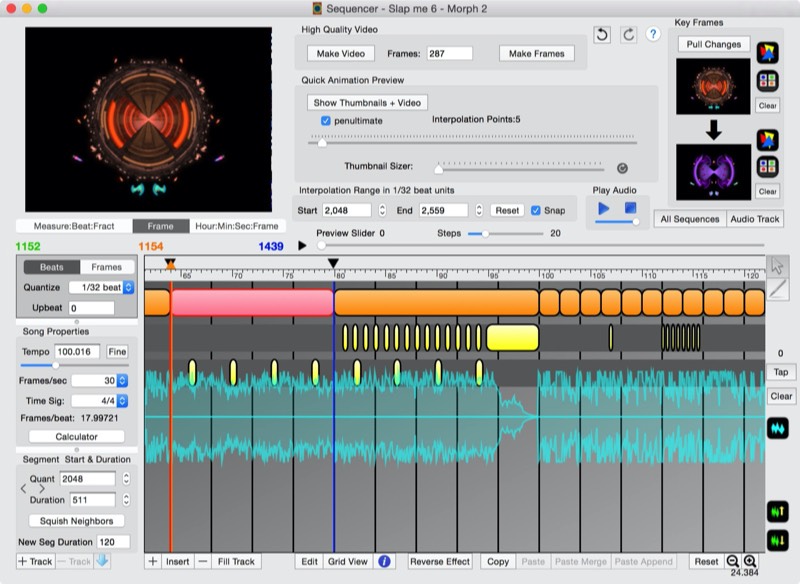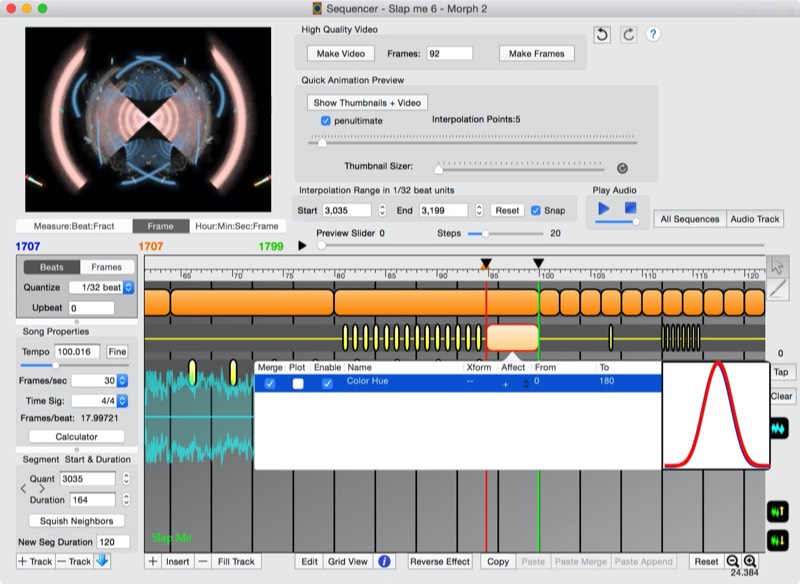Its power and capability is best shown by example:
Lennart's own comments:
"Since this is a entirely new concept I’ve had to invent my own ways of doing things. The best method I’ve arrived at is to sketch the whole thing out with key frames and then add accents with further animation tracks. I think two extra animation tracks are best. If you use too many the rendering time gets longer. It gets longer when you mark every 4th and 8th notes too. You don’t want things to get too busy in the animation, so it becomes a distraction. You have to think flow and rhythm to make a good fractal animation, and keep thinking of new ways to mark the pulse."
"I have found that using colour brightness, transform rotations, background colour and variation weights are the best ways to mark a pulse. But there are many more ways to do it, and I feel I have barely scratched the surface."
Developer's Personal Note:
"Development of the Animation Sequencer began in 2011. I thought it would take 6 months to create - it took almost 4 years! Many times I thought about scrapping the animator project, but a deep determination to see it released kept me going."
"When Lennart showed me the Slap Me animation of Jean-Michel George's Slap Me song, I was totally stunned. It made the long hard years of development with no income totally worth it."


This is the New Manifesto of Computer Music Animation, where the combination of Art and Music (or Music and Art), creates a greater work transcending both genres of human genius.
This is Art! This is Music! This is the finest in Musical Animation.
In the last generation of fractal animation products (including Fractal Architect 3D), most tools for creating animations were limited to either morphing keyframes or transform looping. They create beautiful animations, but the music and the art don’t sync together. They feel “slapped together”.
Other approaches would add beat pulsing, but the resulting animations could lead to rapid viewer fatigue, if the effect was done to excess.
The heart of the problem was that the tools were too limited to create the works of art & music that the animator could see in their minds. They were unable to “take control” of the animation and bring forth the masterpieces that they could visualize.
Most modern musicians and producers use multi-track sequencers to combine individual sounds/melodies/harmonies into a cohesive musical work.
Typically each track represents a different sound (represented as a row on the screen). Each track contains sound fragments arranged horizontally, with the horizontal axis representing time.
The sounds from each track are blended (mixed) together to create the final musical output.
With the FA Sequencer, each track represents a “layer of animation effects”.
The top track specifies either a single fractal keyframe or the morphing of two keyframes. This track creates a base fractal for each video frame as the movie is rendered. (It can also include other property animations too.)
Other tracks add animation effects by animating one of more properties. The beauty of this design is that subsequent tracks (after the first) can have specific purposes. For example, beat pulsing or camera animation.
Animation effects are bundled into separate animation segments. Each segment is represented as a colored rectangle on the sequencer grid.
For each video frame, the animation engine walks (cascades) down from the top track in a straight vertical line. A vertical line represents a fixed moment in time.
The first track creates the frame’s base fractal. As the the line intersects animation segments on lower tracks, those segment’s property animations are applied to the fractal. After the bottom track has been visited, the resulting fractal is rendered as a video frame.
Flame fractals have an immense number of properties that are animatable.
By giving each animation a “purpose” (expressed as "I want this property animation to do this), and dedicating a track to that purpose, greatly simplifies the animator’s work.
Experience has shown that cramming 30 different property animations into a single segment is a nightmare. It works just fine for the animation engine, but you the animator will be confused as predicting the result of each extra property animation becomes muddled.
Combining camera animations with other property animations for example does not work well. A single camera animation might progress over the entire video, while other property animations would be done in a fraction of a second.
Do you put on a blindfold and drive your car down a superhighway with heavy traffic? Do you want to create a long complex animation without being able to do trial renders of bits and pieces of the animation?
Obviously not. You will be doing a lot of fast render previews while creating your animations. The FA sequencer has 4 different ways to do trial rendering of arbitrary sections of the timeline.
Take off the blindfold.
The sequencer builds on top of the extremely powerful and flexible Animation Segment Configuration tool. Every property animation can have its own motion curve.
See: